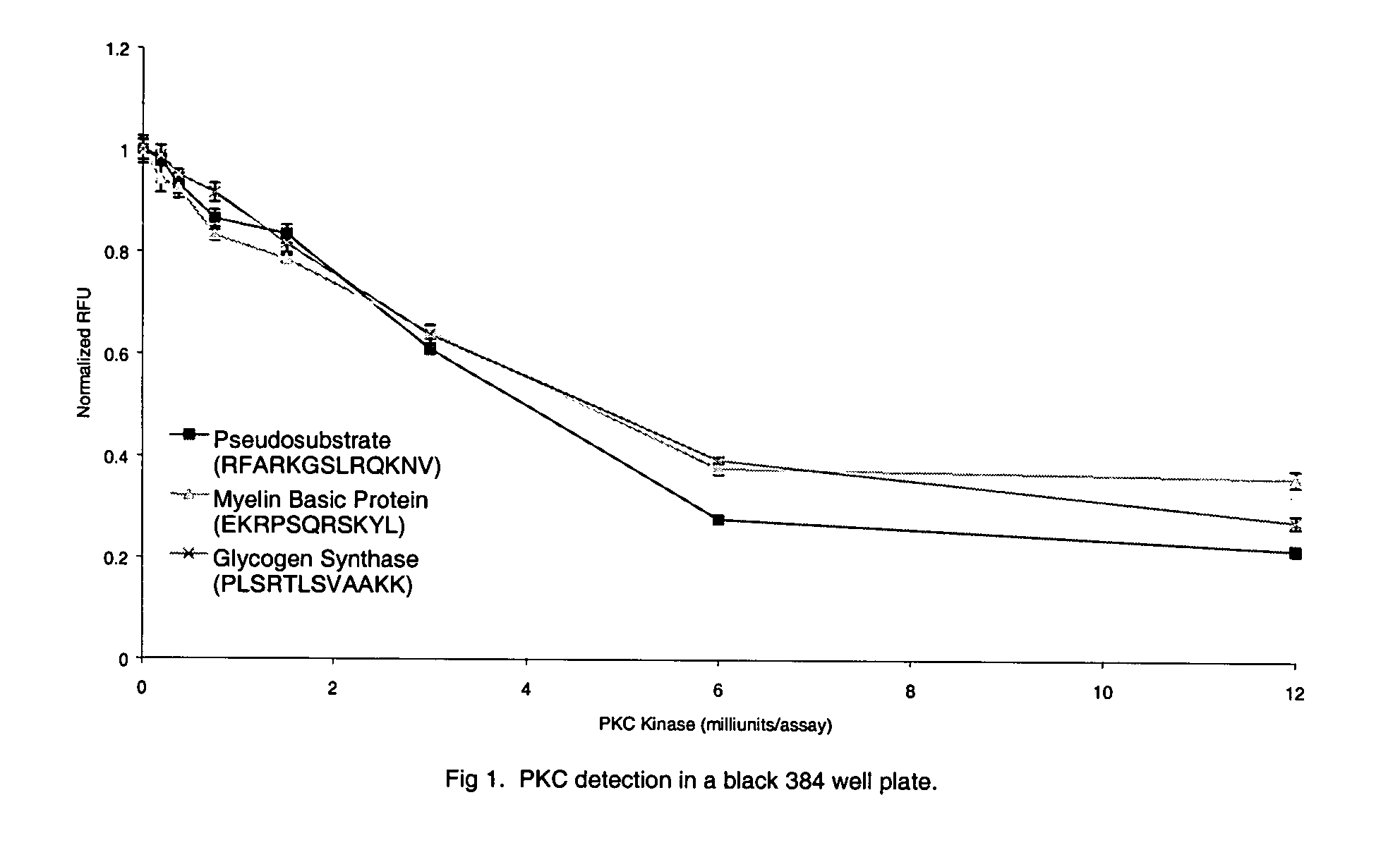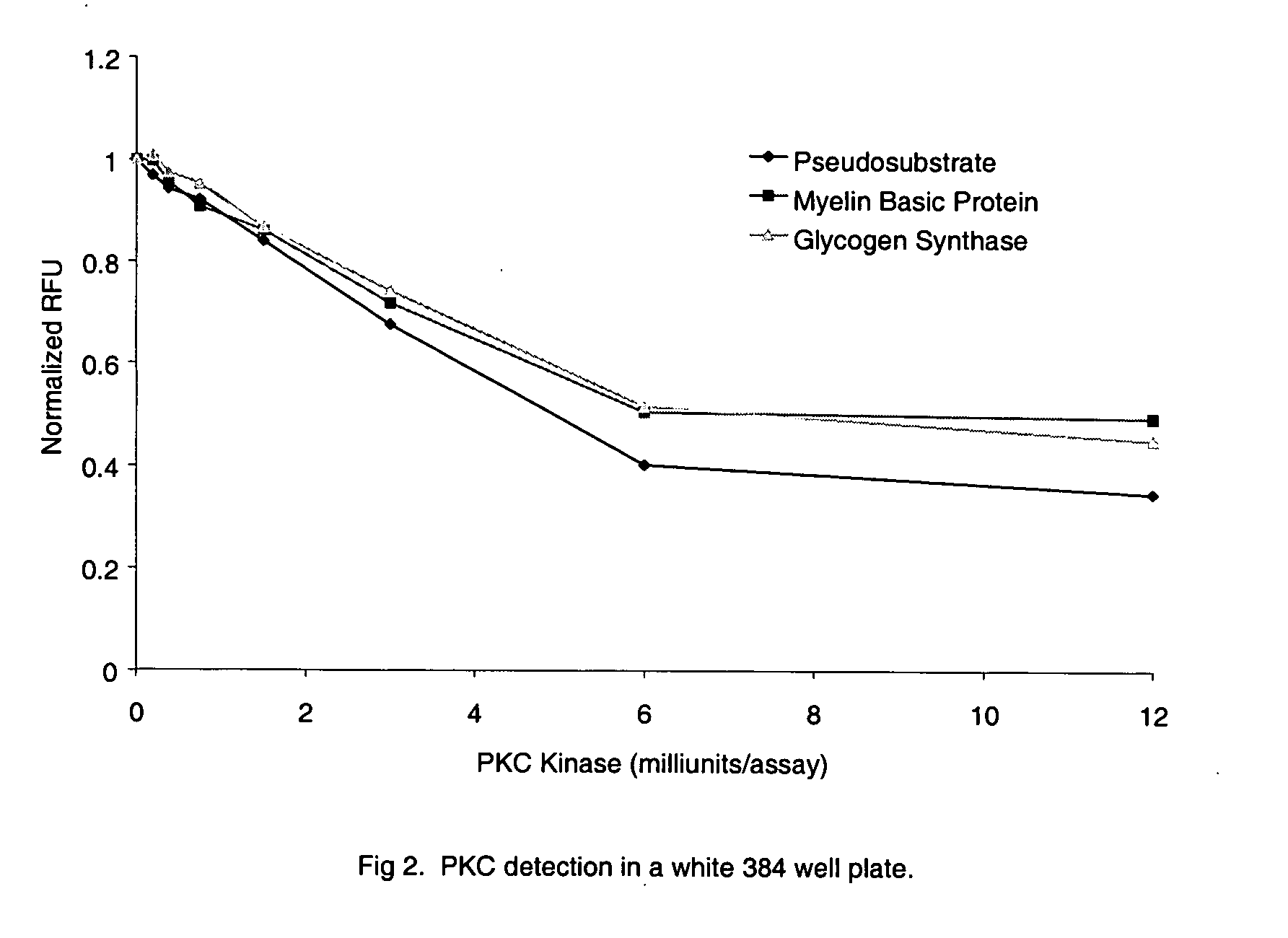Homogenous assay for enzymatic activity
a technology of enzymatic activity and assay, which is applied in the field of assay of enzymatic activity, can solve the problems of increasing cost, affecting the accuracy of enzymatic activity measurement, and the necessity of expensive equipment capable of measuring fp, so as to improve the accuracy of enzymatic activity and confirm the time-dependent effect of enzymatic reaction
- Summary
- Abstract
- Description
- Claims
- Application Information
AI Technical Summary
Benefits of technology
Problems solved by technology
Method used
Image
Examples
example i
Preparation of Working Solution Containing the Paramagnetic Metal Ion as Fe+++
[0074] 9 volumes of Reagent A (0.555 M MES, 44.4 mM iminodiacetic acid, sodium salt, pH 5.8) and 1 volume of Reagent B (200 mM FeCl3 in water) are mixed to give a final Working Solution containing 20 mM Fe3+, 40 mM iminodiacetic acid, disodium salt, 0.5 M MES (morphilinoethane sulfonic acid buffer) with a final pH of approximately 5.5. This reagent can be further diluted with water to yield 0.5× strength working solution or diluted to 0.25× strength working solution with water, for example. The working solution exhibits a time-dependent color change upon mixing. Visually this appears as a darkening of the solution to a reddish brown coloration. The working solution may be utilized immediately in the assay, or may be prepared a day before. Alternatively, the working solution may be briefly warmed to accelerate the color change to a steady state, and then allowed to cool to room temperature prior to use.
[00...
example ii
Fluorescent Measurements
[0076] Fluorescent measurements were generally obtained using a BMG PolarStar fluorometric plate reader (BMG Labtechnologies Inc, Durham, NC) using a 560 / 590 filter set, unless otherwise specified. A Tecan Sapphire plate reader (Austria) with a 560 / 590 excitation / emission and 5 nm bandpass to achieve similar results.
example iii
Enzymatic Reaction Conditions for Kinase Enzymes
[0077] PKC (protein kinase C) assays were carried out in a reaction mixture consisting of 20 mM HEPES, 5 mM CaCl2, 5 mM MgCl2, 1 mM ATP (disodium salt), 1 mM DTT (dithiothreitol), 0.2 mg / ml phosphatidyl-L-serine, pH 7.4. The enzyme preparation (purified PKC containing alpha, beta, and gamma isoforms, Pierce Biotechnology, Rockford, Ill.) was diluted in 20 mM HEPES, 0.05% Triton X-100, pH 7.4, immediately before use in the assay. The enzyme substrates used were either Myelin Basic Protein Peptide 4-14 (EKRPSQRSKYL) (SEQ. ID NO. 5) or Glycogen Synthase Peptide (PLSRTLSVAAKK) (SEQ. ID NO. 6) or Pseudosubstrate Peptide (RFARKGSLRQKNV) (SEQ. ID NO. 7) labeled on the N-terminal amine with Lissamine Rhodamine.
[0078] PKA (protein kinase A) assays were carried out in a reaction mixture consisting of 20 mM HEPES, 0.1 mM cAMP, 5 mM MgCl2, 1 mM ATP (disodium salt), 1 mM DTT, pH 7.4. The enzyme preparation (PKA catalytic unit, Promega, Madison, W...
PUM
| Property | Measurement | Unit |
|---|---|---|
| Length | aaaaa | aaaaa |
| Fluorescence | aaaaa | aaaaa |
| Paramagnetism | aaaaa | aaaaa |
Abstract
Description
Claims
Application Information
 Login to View More
Login to View More - R&D
- Intellectual Property
- Life Sciences
- Materials
- Tech Scout
- Unparalleled Data Quality
- Higher Quality Content
- 60% Fewer Hallucinations
Browse by: Latest US Patents, China's latest patents, Technical Efficacy Thesaurus, Application Domain, Technology Topic, Popular Technical Reports.
© 2025 PatSnap. All rights reserved.Legal|Privacy policy|Modern Slavery Act Transparency Statement|Sitemap|About US| Contact US: help@patsnap.com



